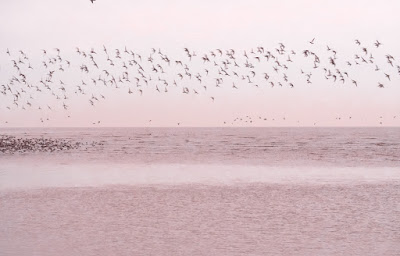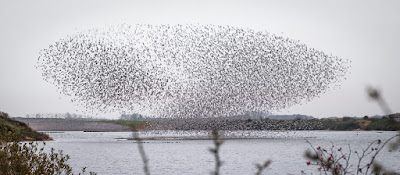Norfolk Coast in Autumn
Swirling knots and deserted beaches
October is a wonderful time of year to explore the Norfolk coast. During my short break here I travelled from Snettisham on the west side of Norfolk, up and around to Holt just below the north coast.
Most of the time the weather was kind, just one rain day and we still ventured out, in the right clothes of course!
The main attraction was the hope of seeing one of wildlife's great seasonal spectacles, one that the RSPB calls the 'wirling wader spectacle'. This happens on some of the biggest high tides (spring tides) that occur at this time of year. The sea rushes in at speed over the mudflats of The Wash and thousands of wading birds are forced into the air, swirling and flowing in great flocks further inland to the saline lagoons where they wait for the tide to turn. The RSPB reserve at Snettisham is the perfect spot to watch this take place.
There are different parts to this event. On the morning we visited the high tide happened shortly after sunrise and as the pink glow of dawn painted the landscape the first flocks began to rise. Over the next hour large flocks of birds, of mainly red knots, geese and oystercatchers, danced and twisted over our heads. It is a mesmerising sight.
The next amazing sight is best seen from one of the bird hides at the side of the saline lagoons. As I entered the new Knots Landing hide I first noticed groups of black and white oystercatchers with their distinctive orange beaks. It looked like they were standing in grey gravel. However, as I watched, I noticed the grey gravel moving and then I realised it was actually hundreds, if not thousands of much smaller birds. These were the red knots, grey in their winter plumage, and they were there in record numbers too - an estimated 140,000 recorded at Snettisham during the weekend we visited. Seeing the masses of birds all together around the lagoon was, for me, the second great part of the spectacle.
The third part of the spectacle takes place about 20 minutes after the high tide. As the tide goes out the flocks in the lagoons begin to stir and start to take off in groups to fly back out to the mudflats where the receding tide will have left good pickings for them. This sight is different, less urgent than the first murmurations, but is still impressive with some super flows and mushrooming clouds of birds to be enjoyed.
The final part for me is once the flocks are back in the mudflats, they form black bands on the mud and every so often a whole flock will take flight and switch to a nearer or further patch of mud. Once again swirling around in waves and spirals. Complete magic!
Other birds were also feeding in the mudflats, I spotted dunlin, sandpipers, greylag geese, curlews, lapwings, shelduck and red shanks.
 |
| Greylag Geese |
The Norfolk coast is also a great location for walking. There are plenty of point to point walks following the Norfolk Coast Path that are easy to do and well signposted. A frequent bus service allows you to do these from one base too. Due to the situation with Covid-19 we decided that public transport wasn't the best thing to use so looked for some circular walks that enabled us to follow the coast path in sections.
One of these walks is the Thornham Circular walk, again well signposted. We started this at the Thornham Deli, which is well worth a visit to pick up some tasty picnic food. You can get the directions here.
This 5 mile walk leaves Thornham and heads towards the coast, through salt marshes to a beautiful remote sandy beach at Holme Dunes where there is a nature reserve and the site of the 'Seahenge' which was a 4000 year old Bronze Age timber circle discovered in 1998 on the beach. This is now in the Lynn Museum. You can read more about the Seahenge here.
We found a bench on the sea wall, a perfect place for our picnic from the deli. Here we overlooked the salt marsh and watched a kestrel hovering over the marsh looking for its lunch too.
The walk continues to the nature reserve at Holme Dunes but it is well worth continuing a little further along to the site of the Seahenge as you can get down to the beach there and it is a beautiful wild spot. At this time of year there were very few people around and it felt remote and raw in its beauty.
On our return to Thornham we walked through another grassy marsh area and I spotted a couple of red tailed birds flitting through the reeds. I later found out that these were rufous bush chats, birds that are rarely seen in northern Europe. In fact they were last seen in Britain 40 years ago! What an unexpected treat.
The north Norfolk coastal area is an amazing place for wildlife. On our drive from Thornham to Holt we were watched by a pair of hares in a stubble field.
I can recommend the places we stayed if you are looking for B&B in the area. In Snettisham we stayed at the Rose and Crown, a characterful village pub with rooms and very friendly staff. In Holt we stayed at Byfords a posh B&B and cafe. Our room here was superb, old fashioned charm complete with a sunken bath in the en-suite bathroom.
Two other circular walks I can recommend are:
Holkham Circular - download a PDF of this walk here.
We did this in the rain, but it was still worthwhile. It follows some of the Norfolk Coast Path (NCP) from Holkham to Well-next-the-Sea then inland along a disused railway path and through an atmospheric avenue of trees into the Holkham Estate.
Highlights of this walk were seeing the beach huts in Wells, all shut up for the season, also watching construction of a new lifeboat station in Wells. We also spotted another hare in one of the fields and saw deer in the Estate parkland.
Blakeney Circular - download a PDF of this walk here.
We started this at Blakeney quay and followed the NCP through the marshes and on to the delightful village of Cley-next-the-Sea with its picturesque windmill overlooking the marshes. We spotted swans, an egret, a hawk, flocks of Brent Geese and quite a few wading birds along the way.
Highlights of this walk were the wide open spaces, big skies, a fabulous pottery called Made in Cley, the Cley Smokehouse (where we stocked up on smoked fish) and a great coffee stop at Artemis.
I feel very lucky to have had such an amazing time experiencing the Norfolk coast in autumn. Memories from this will keep me going through the following weeks of lockdown due to Covid-19. Hopefully I will be able to visit again next year.



















Comments
Post a Comment